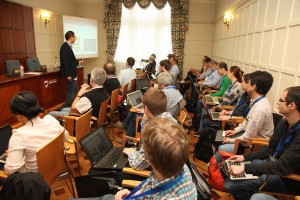The five days were filled with various presentations in small sessions and lively discussions during coffee breaks. Many plenary talks and dedicated sessions summarised and presented the current status of specific areas including detector and accelerator R&D. In the general plenary session overviews on the current status of CLIC, the ILC and on political developments including the European Strategy for Particle Physics (ESPP) and the ILC hosting process in Japan were given.
Within the current European Strategy for Particle Physics the high luminosity LHC upgrades, future energy frontier machines and various neutrino projects are given top priority, but also future e+ e- machines like ILC and CLIC are supported in this strategy. Many ILC enthusiasts were delighted to hear the statement in the talk of Eckhard Elsen about the European Strategy that: “The initiative from the Japanese particle physics community to host the ILC in Japan is most welcome, and European groups are eager to participate.” Elsen also mentioned that the next strategy update is planned for 2019.
Another highlight of the workshop was the talk of Satoru Yamashita from the University of Tokyo who talked about the Japanese political and scientific progress towards the ILC. He opened with a status report from Japan, pointing towards the governmental discussions going on in Japan and with other governments around the world. He also stressed the efforts of the scientific community to further advance the Technical Design Report for the site specific needs of the Kitakami site. He explained that many different organisations like the Japanese embassies, universities and industry are active in promoting the ILC worldwide and of course within Japan to reach scientists, the general public and decision makers alike. He stated: “Although decisions by the Japanese Government will not be made in a one-year timeframe, we maximally strengthen our actions to optimise chances to get real progress in this time scale.”
This thinking was also mirrored in the talk from KEK director general Masanori Yamauchi and in his answer to the question if Japan will make a decision concerning the ILC before the European Strategy will be released in 2019. The answer was positive. They wish to finalise the decision-making progress before the European Strategy is released. He also added that this decision then could be used as input for it.
A steady progress within the ILC community to further improve the design was shown during the sessions and the meetings of the Change Management Board. Within this session Mike Harrison and his colleagues reviewed possible changes for the ILC design with regard to the Kitakami site. In this specific workshop they had presentations concerning the positron source lattice update, the cryogenic layout and the shield wall reduction.
“This workshop showed a steady improvement for the ILC in many areas,” said Dmitri Denisov, America’s representative on linear collider physics and detectors board. “Not only in the design including cost and construction optimisation but also on the physics case.” New results from the LHC were discussed and of course the implications for the ILC. Would it be possible to detect the new particle which was hinted at 750 GeV with the ILC? How could we study it? What other theoretical concepts could be studied at this unique machine? Many such questions were asked and discussed intensely between experts from all around the world. “In almost every theoretical model our understanding of nature benefits considerably from the ILC and its capabilities,” summarized Denisov.
The idea of a photon-photon collider was discussed based on the assumption that some studies can only be done with such kind of collisions. A collider like this could be built in a very similar way as the ILC using the same technology for acceleration but introducing lasers for photon production and only accelerating electrons instead of electrons and positrons.
More topics from other projects ranging from superconductive cavities and detector designs to software simulations and theoretical models were openly discussed at this workshop. “Every lesson we can learn from other projects helps to improve our design and brings us a step closer to the ILC realisation,” said Denisov. Speakers at all these sessions were not only senior scientists because many young scientist had the opportunity to discuss their work with all participants. “Giving young scientists and students the chance to be part of a project like the ILC is not only an opportunity for them but also for the project,” commented Denisov. “Overall this workshop showed the ILC is actively moving forward on all parts of the project.”
Therefore many enthusiasts are looking forward to the next LCWS workshop to be held in Japan from 5 to 9 December 2016. This next workshop will be an opportunity to get a first view at the possible site of the machine because the workshop will take place in Morioka, one of the cities “closest to home” for the ILC as possible right now. It is also one of the many centers of ILC design activity and public outreach.


Recent Comments